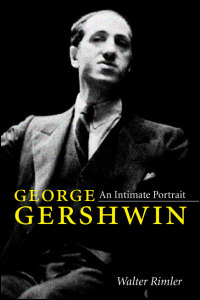 When I started this biography of George Gershwin I already knew quite a bit about him. I’d been intrigued—that’s probably too mild a word but I’d rather not go all the way to obsessed—with him since, as a fourteen-year old, I’d first heard the Rhapsody in Blue. In a prior book, A Gershwin Companion (an analysis of his music, not his life), I spoke, in my Introduction, about how my life was forever changed when, as a boy, I inadvertently found myself “in a room in which a recording of the Rhapsody in Blue was playing” and how “after months of listening to that recording I was finally sated enough to turn the disk over, whence I spent the next several months spellbound by the Concerto in F.”
When I started this biography of George Gershwin I already knew quite a bit about him. I’d been intrigued—that’s probably too mild a word but I’d rather not go all the way to obsessed—with him since, as a fourteen-year old, I’d first heard the Rhapsody in Blue. In a prior book, A Gershwin Companion (an analysis of his music, not his life), I spoke, in my Introduction, about how my life was forever changed when, as a boy, I inadvertently found myself “in a room in which a recording of the Rhapsody in Blue was playing” and how “after months of listening to that recording I was finally sated enough to turn the disk over, whence I spent the next several months spellbound by the Concerto in F.”
I began reading whatever I could find about the man but there wasn’t all that much in those days, and what there was did not tell the whole story. In fact, the omissions were so glaring that they seemed to have been intentionally—and not all that innocently—made.
One puzzle was the nature of George’s relationship with brother-lyricist Ira, particularly in the late spring of 1937 when George, at age 38, was seriously ill with an as yet undiagnosed brain tumor. In The Gershwin Years, published in 1958 by two friends of Ira, Lawrence Stewart and Edward Jablonski, we get this odd statement: “At the end of the spring the brothers compromised upon a new collaboration: Ira would buy a home in Beverly Hills and would also construct a studio-cottage that George, on short trips West, could use.” That did not sound like a “new collaboration.” It sounded like a breakup of the partnership, a split. Up to that moment, the brothers had never lived more than a few feet from one another. In fact, they had spent most of their lives living under the same roof.
Also odd was the following statement, from the same book, about George: “near the end of his life he finally moved out of 1019 [the home he was renting, along with Ira and Ira’s wife Leonore] and into [songwriter] Yip Harburg’s Beverly Hills home, where he could at last have silence.” This makes it sound as if George calmly packed his bags and relocated to a place where he could find a little rest and relaxation. Obscured is the fact that he moved into the Harburg house just one week before he died and that his condition at that point was so bad he could not have made the decision for himself. What was really going on? Had he been forced out of his own home?
And then there was his relationship with composer Kay Swift. In The Gershwin Years the fact that Gershwin and Swift had been openly having an affair as well as a close musical relationship since 1926 is not mentioned. In fact, her name does not come up in the text of the book until a discussion of Gershwin’s 1934 labor on Porgy and Bess, when this line appears: “The work piled up; assisting in the boresome job of copying were two faithfuls, Kay Swift and Dr. Sirmay.” So, according to the authors, she was merely his musical copyist.
Recent Gershwin biographers have paid more attention to the Gershwin-Swift relationship but none has written much about the interesting fact that for most of her years with Gershwin, Swift was married to James Paul Warburg, scion of the Warburg banking family. These biographers have refrained from delving into the complexities of this triangle. They have also failed to mention the fact that Ira’s wife Leonore never had much use for Kay (or vice versa), or that George was equally un-fond of Leonore, or that Ira and Leonore were unhappily dependant on one another, or that all these relationships and interrelationships came to a head when George became mortally ill.
These, then, were the subjects I set out to explore when I began researching this book. I wanted to know more about the people closest to George Gershwin and the nature of his connections to them. I wanted, in short, to get as close to him as I could in order to find out if, as so many of his intimates (including Swift) said, he was really just like his music. Could a man really be like the Rhapsody in Blue?
*****
Walter Rimler is the author of the new book George Gershwin: An Intimate Portrait.
